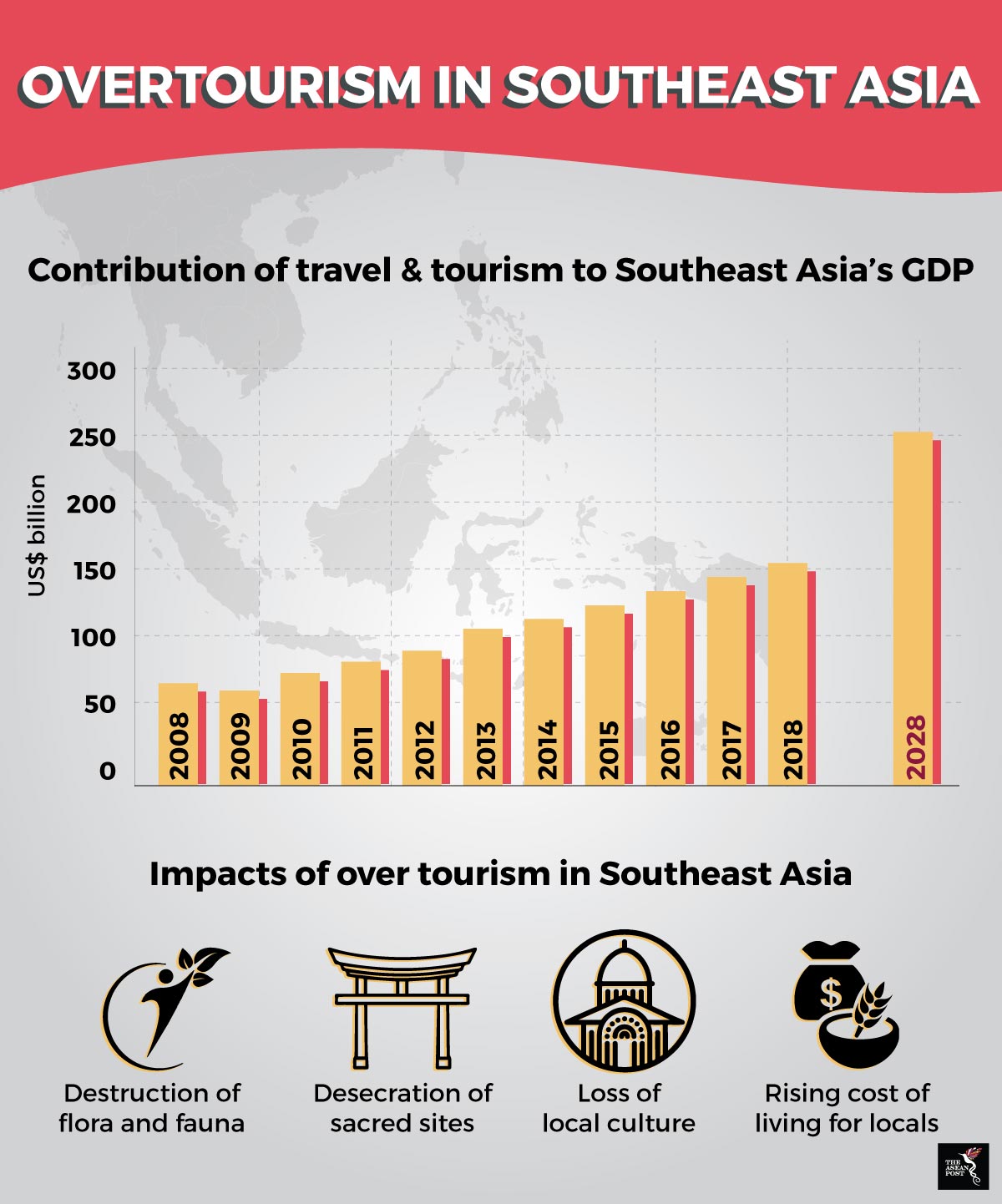Over the past decade, Southeast Asia has increasingly become one of the world’s most popular tourist destinations. This comes as no surprise as the region isn’t short of beautiful beaches, lush forests and historical sacred sites. Southeast Asia also has its fair share of UNESCO World Heritage sites. With such attractions and the proliferation of budget airlines, the number of tourists in the region has risen rapidly.
According to the United Nation’s (UN) World Travel and Tourism Council, the region is expected to attract 125,784,000 international tourist arrivals this year. The rise of the region’s tourism industry has been a boon to the economies of Southeast Asia too. The total contribution of travel and tourism to Southeast Asia’s gross domestic product (GDP) in 2017 was US$330 billion, which accounts for 12% of the region’s GDP. The World Travel and Tourism Council forecasts this number to rise to US$598 billion in 10 years.
While tourists in the region are always welcome, concerns have been raised whether the region is capable of handling the massive spike in tourist numbers.
Thailand recently shut down Maya Bay, one of its popular tourist destinations after it was found that the local reefs there were dying as a result of the local tourism industry. The accumulated damage of snorkelling, swimming and speed boats whizzing over its waters has finally taken a toll on Maya Bay.
What happened to Maya Bay is not a one-off case. In fact, it is a symptom of a much larger problem often termed as “overtourism.” Attempting to define the term, Rafat Ali, CEO and founder of Skift, a global travel industry intelligence company, described it as “a potential hazard to popular destinations worldwide”. “The dynamic forces that power tourism often inflicts unavoidable negative consequences if not managed well,” he explained.

Sources: Various sources
The consequences of overtourism is most apparent in Southeast Asia’s beach and island destinations, which are likely to receive larger numbers of tourists as opposed to other parts of the region. Thailand is on the list of such destinations. The country's beautiful islands of Phuket, Koh Lipe and Koh Phangnan have attracted all sorts of tourists, from party-goers to families. This has caused irreversible damage to marine life surrounding these islands. A study revealed that 72 percent of Thailand’s coral reefs are under threat.
The Philippines’ Boracay Island was also ordered to shut its doors for six months recently. The decision was made by President Rodrigo Duterte, who called the island a “cesspool” during a visit. The island previously known for its pristine waters and white sands has been plagued with pollution as sewage from local hotels and restaurants is being dumped indiscriminately into the ocean.
Overtourism doesn’t just affect the flora and fauna at these locations. It also has a large effect on local communities too. One of the main reasons why Southeast Asia is very attractive to international tourists is the low currency exchange rate in the region. However, this will have an adverse effect as it usually drives prices up at tourist destinations and the locals who live in these areas will have to deal with the higher cost of living.
The influx of tourism can also affect property prices, which will drive local communities out of these areas. As some tourist spots become more popular, property there becomes more attractive and valuable. This will cause the hollowing out of local communities and local businesses from the town, replacing them with tourists, property speculators and franchises that have no connection with the local history and heritage. Inadvertently, local cultures and charm that made the city a tourist hub in the first place will start to disappear. This is evident in many popular tourist destinations. Among them is the island of Bali in Indonesia where non-local businesses dominate the tourism industry. In Bali, an estimated 85% of tourism related businesses are owned by non-Balinese. Georgetown in Malaysia also faces a similar problem. Long-time residents are complaining that they can no longer afford to pay their rent as tourists have driven up prices there.
There is a catch-22 in pursuing tourists; on one hand it provides economic growth and local jobs, and on the other it can completely transform a place for the worse. There are still plenty of tourist destinations in the region that haven’t been harmed by overtourism and it is essential we prevent it from happening in the near future. The lessons learnt from Maya Bay and Boracay Island are painful reminders of what overtourism can do.
